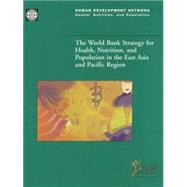The World Bank Strategy for Health, Nutrition, and Population in the East Asia and Pacific Region
, by Saadah, Fadia- ISBN: 9780821347393 | 082134739X
- Cover: Paperback
- Copyright: 1/1/2001
"The past three decades have seen impressive advances in development in the East Asia and Pacific (EAP) region. Gains in income and education have been accompanied by reductions in high levels of infant and child mortality and fertility, improved nutritional levels, better hygiene and sanitation and increased access to health care."This book is intended to help address the development challenges and policy directions for the World Bank's Health, Nutrition, and Population (HNP) sector in the region. It highlights key lessons learned in the EAP region and presents policy options and recommendations to strengthen the quality and effectiveness of Bank-supported HNP operations.The development of this strategy is closely linked to the Bank's overall sector strategy that identified three major development priorities:- Improve the health, nutrition, and population outcomes of the poor- Enhance the performance of health care systems- Secure sustainable health care financing.A Health, Nutrition, and Population Strategy for the East Asia and Pacific Region is meant to provide the guidelines and parameters to be used at the country-level. Strategy development will be ongoing, building on best practices within the region as well as internationally.This book is an invaluable resource for all those interested in the field of health, nutrition, and population in the context of international development.







